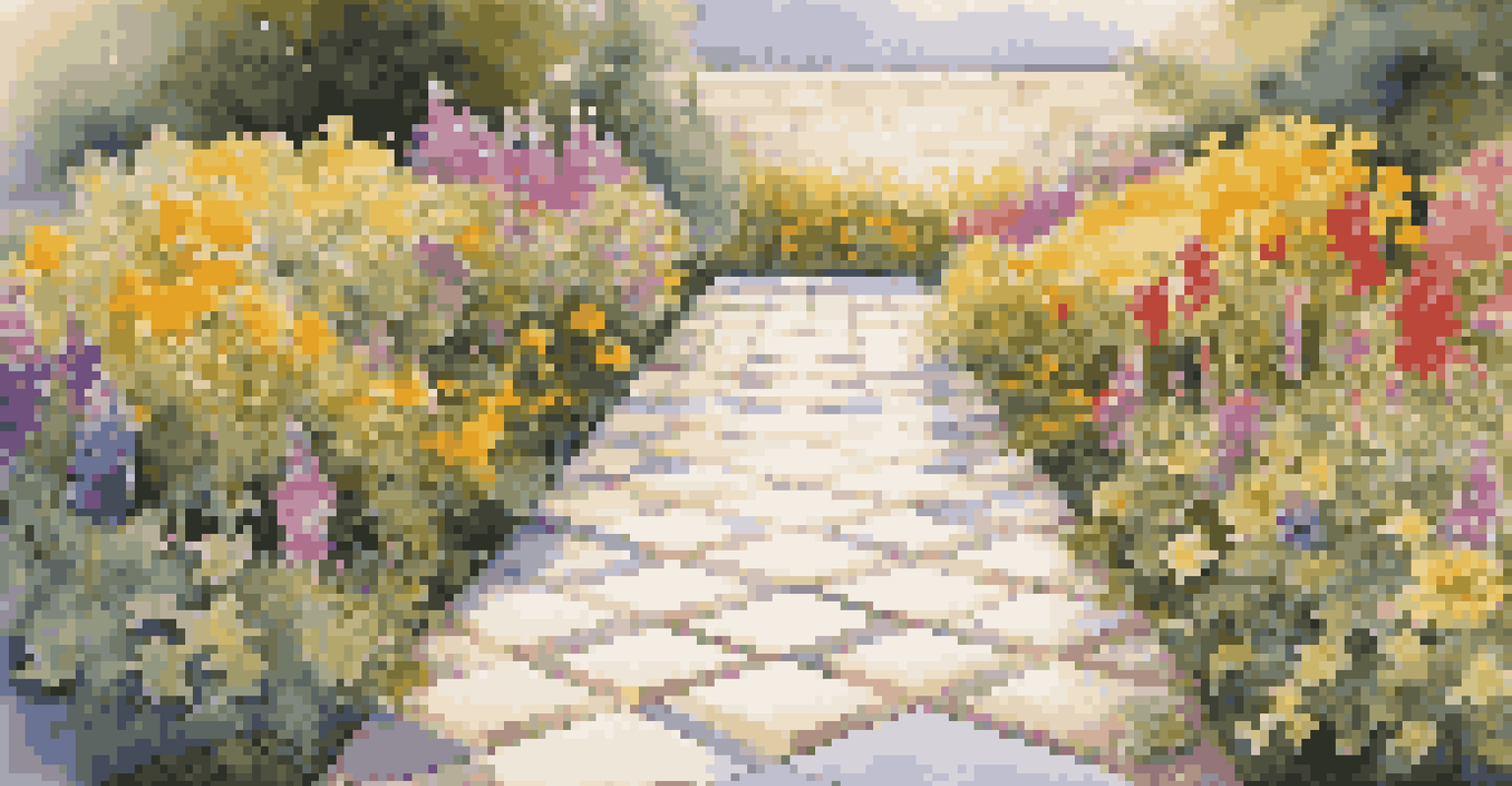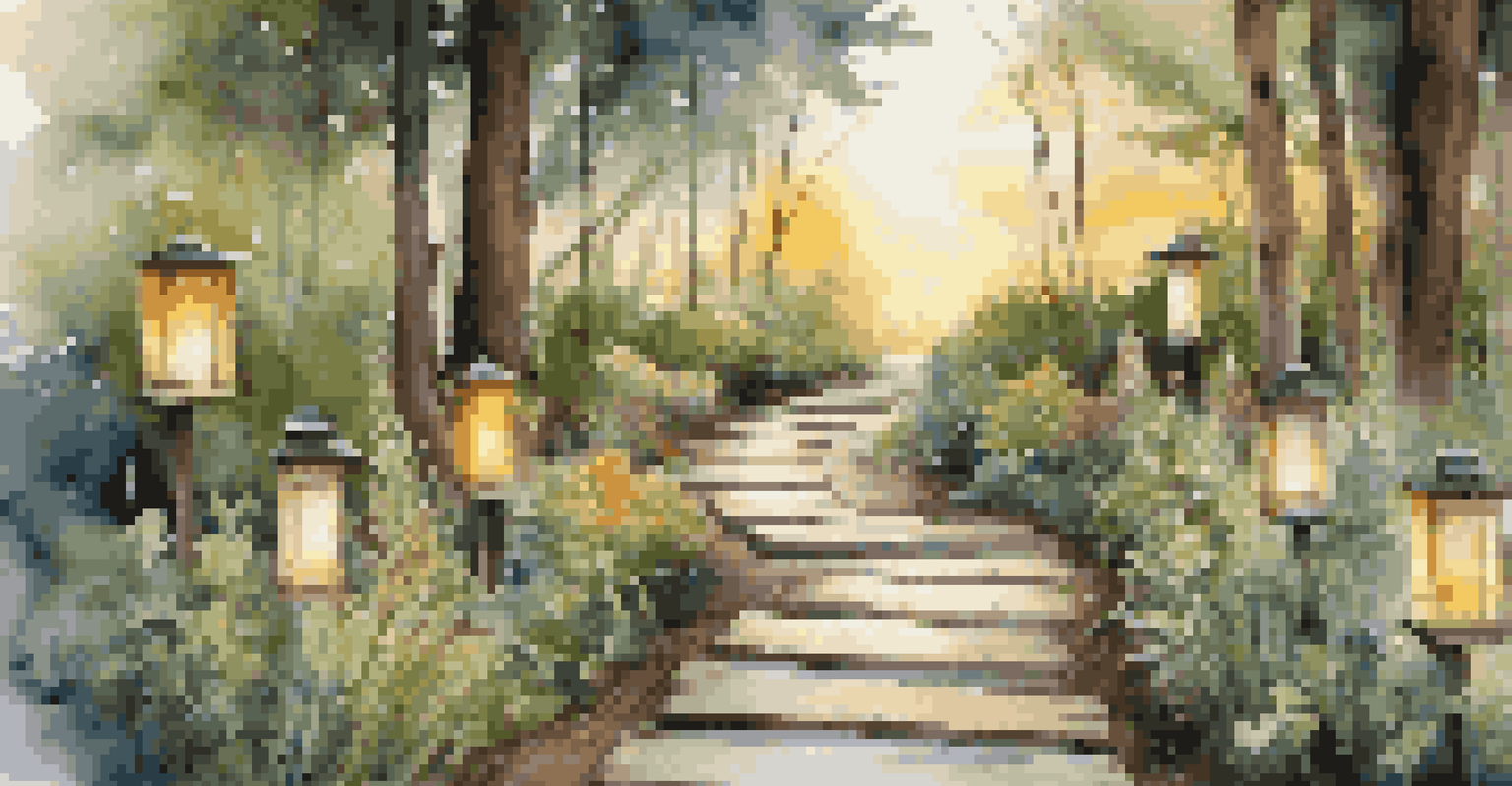Decorative Pathways: Trends for Beautiful Garden Walkways

The Importance of Garden Pathways in Landscape Design
Garden pathways serve as the veins of your outdoor space, guiding visitors through your landscape. They add structure and balance, allowing for a harmonious flow between different areas of your garden. Without them, a beautifully designed garden might feel disjointed and confusing, making it hard for visitors to appreciate the full beauty of your plants and features.
A garden pathway is not just a way to reach a destination; it is a journey through beauty and nature.
A well-planned pathway can also frame your garden’s best elements, drawing attention to focal points like sculptures, flower beds, or water features. Think of it as a canvas that enhances the artwork of your garden. By choosing the right materials and designs, you can create walkways that are not only functional but also visually appealing.
Moreover, pathways improve accessibility, ensuring that everyone can enjoy the beauty of your garden. Whether it’s a smooth surface for strollers or a sturdy route for garden tools, these walkways make your outdoor space more usable and inviting.
Natural Materials: Embracing Earthy Textures
Natural materials like stone, gravel, and wood are making a big splash in garden pathway trends. These materials not only blend seamlessly with the environment but also add organic textures that enhance the rustic charm of your garden. For example, a pathway made of rough-hewn stones can evoke a sense of timeless beauty, while gravel offers an easy-to-maintain option that allows for creativity in design.

Using natural materials can also help you create a more sustainable garden. They often require less energy to produce and can be sourced locally, reducing your carbon footprint. Plus, as they age, they generally develop a patina that adds character and depth to your garden path.
Pathways Enhance Garden Flow
Well-designed garden pathways provide structure and accessibility, guiding visitors and highlighting key features.
When considering natural materials, think about how they interact with the surrounding flora. A carefully chosen stone path can complement blooming flowers or lush greenery, creating a cohesive and inviting atmosphere in your outdoor space.
Geometric Patterns: Adding Structure and Style
Geometric pathways are on the rise, offering a modern twist to traditional garden designs. By incorporating shapes like squares, rectangles, or even hexagons, you can create a striking visual impact that draws the eye. This design trend works particularly well in contemporary gardens, where clean lines and symmetry reign supreme.
The landscape is a canvas, and the pathways are the brush strokes that bring it to life.
For instance, using square pavers arranged in a checkerboard pattern can transform a simple walkway into a stunning focal point. This approach not only adds visual interest but also allows for creativity with color and material choices, making your garden pathway truly unique.
Additionally, geometric patterns can serve practical purposes. They can help define specific areas of your garden, guiding visitors through different sections while maintaining an organized look. This structure enhances the overall flow and usability of your outdoor space.
Eco-Friendly Pathway Options for Sustainable Gardens
As more gardeners become environmentally conscious, eco-friendly pathway options are increasingly popular. Materials like reclaimed wood, permeable pavers, or recycled concrete not only reduce waste but also contribute to a sustainable garden ecosystem. These materials can help you create beautiful walkways without sacrificing your commitment to the environment.
Permeable pavers are particularly noteworthy as they allow water to seep through, reducing runoff and promoting groundwater recharge. This not only benefits your garden but also plays a part in preserving local ecosystems. Imagine walking through a lush garden where every element, including the pathways, works in harmony with nature.
Natural Materials are Sustainable
Using natural materials like stone and gravel not only adds visual appeal but also promotes eco-friendly gardening practices.
Choosing eco-friendly materials can also spark conversations about sustainability among your visitors. By showcasing your commitment to the environment, you inspire others to consider their choices in gardening and landscaping, fostering a sense of community and shared responsibility.
Lighting Your Pathways: Enhancing Safety and Ambiance
The right lighting can transform your garden pathways from functional to enchanting. Incorporating soft, ambient lights along your walkways not only enhances safety during evening strolls but also adds a magical touch to your outdoor space. Think about how twinkling lights or strategically placed lanterns can create a warm, inviting atmosphere.
Solar-powered lights are an excellent choice for eco-conscious gardeners. They harness the sun's energy, providing illumination without increasing your electricity bill. Plus, they come in a variety of styles, allowing you to choose fixtures that complement your pathway design beautifully.
Additionally, consider the placement of your lights. Highlighting curves and turns in your walkway can create a sense of movement, guiding visitors through your garden. This thoughtful approach to lighting adds another layer of interest and functionality to your decorative pathways.
Colorful Pathways: Making a Bold Statement
Gone are the days when pathways were merely functional; today, they’re an opportunity for bold expression! Brightly colored tiles, painted stones, or vibrant gravel can make your garden path a standout feature. Imagine walking on a rainbow-hued pathway that energizes your outdoor space and reflects your personality.
Color can also play a role in mood setting. For instance, warm colors like reds and oranges can create a lively atmosphere, while cooler tones like blues and greens can evoke a sense of calm. By choosing colors that resonate with you, you can craft a path that not only leads the way but also enhances the overall vibe of your garden.
Lighting Boosts Safety and Charm
Proper lighting transforms pathways, enhancing safety and creating an inviting ambiance for evening strolls.
Incorporating colors into your pathways also allows for seasonal changes. Swap out tiles or add decorative elements to reflect the changing seasons, keeping your garden feeling fresh and inviting throughout the year.
Incorporating Plant Life: Blending Pathways with Nature
Why not let nature join the fun? Incorporating plant life alongside your pathways can create a seamless transition between your walkways and garden beds. Think of low-growing plants like creeping thyme or sedums that can spill over the edges of your path, softening the lines and adding a touch of greenery.
This approach not only enhances the beauty of your pathways but also encourages biodiversity in your garden. By attracting pollinators and beneficial insects, you create a thriving ecosystem that benefits your plants and overall garden health. It’s a win-win for both aesthetics and nature.

Moreover, utilizing plants as part of your pathway design can help define spaces. By strategically placing taller plants or shrubs adjacent to your walkways, you can create natural borders that guide visitors while adding depth to your garden layout.